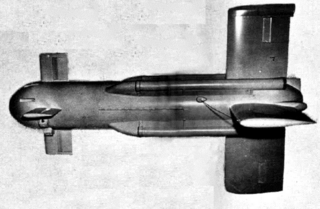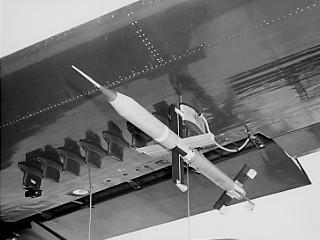
The AUM-N-2 Petrel, also known as Kingfisher C and AUM-2, was an air-to-surface missile produced as part of Project Kingfisher for the United States Navy. Intended for use against enemy surface ships and surfaced submarines, giving aircraft the ability to deliver aerial torpedoes from outside the range of defensive armament, it saw brief operational service in the late 1950s. The project was never considered a high priority by the Navy however, as it was useless against submerged submarines, which were considered the greatest potential threat.

The Gorgon missile family was a series of experimental air-to-air, air-to-surface, and surface-to-surface missiles developed by the United States Navy's Naval Aircraft Modification Unit between 1943 and 1953. The immaturity of the technology involved meant that none of the Gorgon missiles achieved operational service, however they were extensively used in the development of guided missile controls and guidance technologies.

Project Kingfisher was a weapons-development program initiated by the United States Navy during the latter part of World War II. Intended to provide aircraft and surface ships with the ability to deliver torpedoes to targets from outside the range of defensive armament, six different missile concepts were developed; four were selected for full development programs, but only one reached operational service.

The LBD-1 Gargoyle was an American air-to-surface missile developed during World War II by McDonnell Aircraft for the United States Navy. One of the precursors of modern anti-ship missiles, it was extensively used as a test vehicle during the late 1940s.

The Brazo missile was an American project, intended to produce an anti-radiation missile for air-to-air use. Developed by Hughes Aircraft and based on the AIM-7 Sparrow air-to-air missile, the Brazo underwent a series of successful test firings; however, the program was terminated at the end of its test program.

The Little Joe, also known by the United States Navy designation KAN, was an early American ship-based, short-range surface-to-air missile, the development of which was initiated in 1945 as a response to the Kamikaze tactics used by the Japanese. Although the missile was successfully tested, the end of World War II removed the requirement for the missile, and the project was abandoned in 1946.

The Bombardment Aircraft Rocket, also known as BOAR, the Bureau of Ordnance Aircraft Rocket, and officially as the 30.5-Inch Rocket, Mark 1, Mod 0, was an unguided air-to-surface rocket developed by the United States Navy's Naval Ordnance Test Station during the 1950s. Intended to provide a standoff nuclear capability for carrier-based aircraft, the rocket entered operational service in 1956, remaining in service until 1963.

The 3.5-inch Forward Firing Aircraft Rocket, or 3.5-Inch FFAR, was an American rocket developed during World War II to allow aircraft to attack enemy submarines at range. The rocket proved an operational success, and spawned several improved versions for use against surface and land targets.
RIM-85 was a short-lived project by the United States Navy to develop a surface-to-air missile for the defense of naval vessels. Developed during the late 1960s, the project was cancelled before the start of detailed design work.
RIM-101 was a short-lived project by the United States Navy to develop a surface-to-air missile (SAM) for the defense of naval vessels. Developed during the early 1970s, the project, possibly derived from the RIM-7 Sea Sparrow, was cancelled before the start of detailed design work.

Glomb, from "glide bomb", was a project undertaken by the United States Navy during World War II to develop an unmanned aircraft for delivering bombs to high-value, well-protected targets without risk to aircrew. The project proceeded through the war, producing several prototype aircraft, but technical limitations meant no Glombs saw operational service and the program was cancelled at the end of the war.

The AGR-14 ZAP was an air-to-surface unguided rocket developed by the United States Navy in the late 1960s. Intended for use in the suppression of enemy air defenses role, the rocket reached the flight-testing stage before being cancelled.
The ASM-N-5 Gorgon V was an unpowered air-to-surface missile, developed by the Glenn L. Martin Company during the early 1950s for use by the United States Navy as a chemical weapon delivery vehicle. Developed from the earlier PTV-N-2 Gorgon IV test vehicle, the program was cancelled without any Gorgon Vs seeing service.

The AAM-N-5 Meteor was an early American air-to-air missile, developed by the Massachusetts Institute of Technology and Bell Aircraft for the United States Navy. Initially, both air-launched and ship-launched versions were considered. Versions designed for launch from carrier-based aircraft proceeded to the flight testing stage before the project was cancelled.

The CTV-N-2 Gorgon IIC – also designated KGN, KUN, and CTV-2 – was an experimental drone, originally intended as a surface-to-surface missile, developed by the United States Navy near the end of World War II. It was used to test control and homing systems for guided missiles, and was also produced in small numbers as a target drone under the designations TD3N and KD2N.

The ASM-N-6 Omar was a short-range air-to-surface missile developed for and evaluated by the United States Navy in the early 1950s. Intended to use existing unguided rockets as a basis and using a novel guidance system involving optical beam-riding, the program was unable to resolve difficulties with the guidance system and was cancelled without entering service.

SAM-N-8 Zeus, also known as Zeus I, was a project by the Naval Ordnance Laboratory of the United States Navy to develop a guided anti-aircraft artillery shell for launch from 8-inch (200 mm) guns. Tested in the late 1940s, it was overtaken by advances in guided missile technology.
The AUM-N-4 Diver, also known as Kingfisher D and AUM-4, was a proposed anti-ship and anti-submarine missile, developed for use by the United States Navy in the late 1940s. It was intended to carry a rocket-propelled torpedo that used a single rocket motor for both airborne and underwater propulsion; due to technical issues encountered in the development of the torpedo, no missiles were built before the program was cancelled.

The AUM-N-6 Puffin, also known as Kingfisher F and AUM-6, was an anti-ship and anti-submarine missile developed for use by the United States Navy in the late 1940s. Pulsejet-powered and intended to allow an aircraft to launch a torpedo or bomb from stand-off range, it was flight-tested but failed to enter operational service.

The SUM-N-2 Grebe, also known as Kingfisher E and SUM-2, was a rocket- and pulsejet-powered anti-ship and anti-submarine missile developed by the United States Navy in the late 1940s. Intended to allow a ship to deliver a torpedo at a significant distance from the launch location, it proved impractical in trials, and did not enter operational service.
















